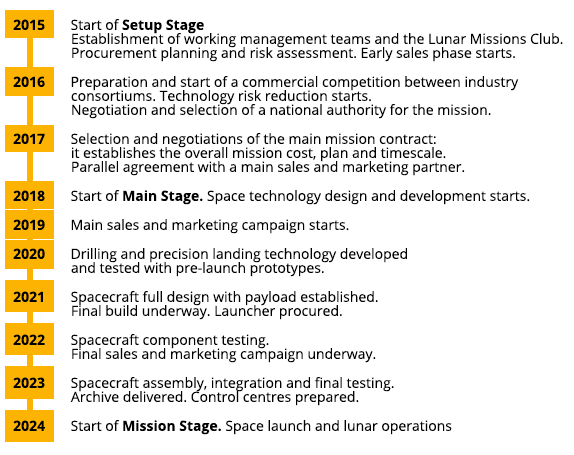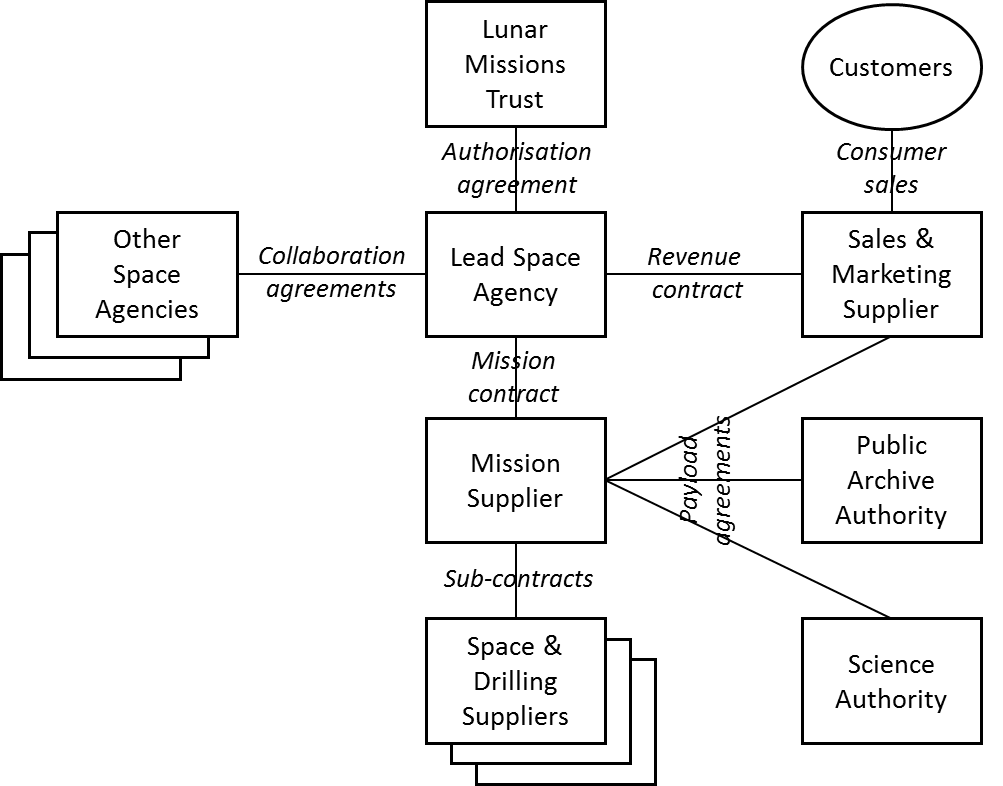Programme Plan
Timeline
We expect Lunar Mission One’s programme to last a decade. It starts with a three year Setup Stage in which the main contracts for the mission and for sales and marketing are competitively negotiated and agreed. This is currently the point where we are at.
This will be followed by the main Development Stage over six years, accompanied by the main sales campaign, and itself ending with the mission launch. The mission is then likely to take four to six months, with the prospect of extended science measurements over a few years.
The current view of the timeline is this:

Commercial
Lunar Mission One’s expected contract structure for the main stage is below:

A lead space agency would have the authorization of the Lunar Missions Trust to act as the contracting authority for the project and to provide the legal powers for the space mission, under arrangements set up by Lunar Missions Ltd. The agency would assist with managing intergovernmental relations.
Under contract to that agency, the mission would be managed commercially by an industrial consortium, likely led by a major international aerospace company which itself would act as programme leader for the mission and its technology development. It would select all components of mission technology and subcontract as required for the most efficient commercial deliverables. Its scope would cover the spacecraft and its complete mission profile: launching, spaceflight trajectory, precision landing, lunar surface operations, drilling and science support.
The industrial consortium would take full cost risk for the spacecraft design, development and delivery. It would be paid by project milestones leading to a core financial return on acceptance for launch. Its equity investment component would be rewarded by staged successes for lunar landing, drilling, archiving and science support. So the mission supplier takes operational performance risk.The launch itself would be insured.
Under a further contract to the agency would be a sales and marketing supplier with the role of maximizing revenues for and during the project. Probably a global consumer brand, it is expected to franchise its local promotion and sales to regional franchisees around the World. It would collate the private archive, with information and DNA/hair, for the mission supplier to deliver as a payload to the Moon.
The sales and marketing supplier would take a portion of revenues, shared amongst its franchising, and pass the remainder to the lead agency for paying the mission supplier. At the end of the mission, all the surplus goes to the Trust.
During the Setup Stage, Lunar Missions Ltd will identify and negotiate with a public archive authority and a science authority to act as leads for their respective payloads of the mission.
In the event of mission failure, and conditional on the level of revenues, the Trust is expected to authorise a repeat mission at no further cost to customers.
Led by Lunar Missions Ltd with its management sponsors in a form of integrated procurement team, the contract structure is expected to take three years to put together. This is the Setup Stage objective.
Funding
Lunar Mission One relies on a form of crowdfunding, in which members of the public pay for it as it proceeds and so reducing, or even avoiding, politically difficult government spending and even more difficult and expensive capital market investment. The mechanism for funding is phased as the project progresses.
- The first stage, the Prep Stage, was funded through the Internet crowdfunding platform Kickstarter, raising $1m and establishing a very early community of enthusiasts.
- The Setup Stage will be funded by early sales, principally for reservations of the private archive, and backed by management sponsors who underwrite their in-kind contributions for a reward which is paid when the main mission contract is signed. The sponsors therefore take a form of procurement risk. Including costs of the industrial consortiums bidding for the mission contract, the Setup Stage is expected to cost between $30m and $35m.
- The Main Stage will be funded by the main sales and marketing campaign, requiring about $750m net of revenue costs, less if government financial support for key technologies is secured. Any temporary cash flow shortage from revenues would be funded by the industrial consortium as a form of loan. To insulate the mission supplier from the risk of overall revenue shortfall, and to secure low cost project financing, the lead space agency would underwrite a minimum revenue up to an acceptable limit. In return, its government would be paid a form of tax revenue from the surplus. The government concerned would not be expected to pay cash, unless the revenues fell significantly short.
Risks
Lunar Mission One is innovating and that automatically carries risks. Its programme risks and mitigations cover revenues, costs, timescales and the project’s output deliverables themselves. Broadly, over time the risks will go down as the costs go up, and the project will address the major uncertainties early on.
- Revenue risks and contingency plans are identified in The Revenue Case. The project will constantly review its product definition and marketing strategy in the light of market response as the project progress, especially during the Setup Stage, with its enthusiasts and pilot studies contributing to the development of the market opportunity. The project expects to collaborate with several institutions, and expects a number of commercial alliances to enhance its market positioning.
- In the event that costs look like not being covered by revenues, even after government support for key technologies, then the project could reduce its mission requirement.
- The drilling depth objective could be reduced. That would lead to lesser science benefit and a shorter archival preservation timescale, though still very long. And a less ambitious drilling technology would have less potential for consequential developments beyond this mission.
- The project could reduce its science package, but again with less science benefit.
- It could even just leave the archive on the surface, and look to a later lunar South Pole mission to drill down and place it for good.
- Finally, there may be pressure to postpone the space mission altogether, but to maintain the archive’s construction for a future opportunity.
- Pressure on the mission launch date is not as important as pressures on revenues and costs. The date can be flexible, especially early in the project, though if it becomes too long away the project risks a lack of interest, and a date that is continually delayed is a sign that the project is not under control.
- The project’s deliverables are fixed by the mission contract. Up to then, the project will negotiate with the industrial consortium a mission that it is capable of delivering, such that it can be held responsible for performance and will get rewarded for achievement. How it does it is up to the consortium, so it may change its technical specifications, its suppliers and its management to achieve its deliverables – the transportation and placement of the archive and the science instruments in working order.
